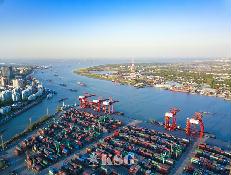2022-08-09 08:54
Understanding the Global Supply Chain Disruption

Warehouses are experiencing labor shortage, manufacturers are surmounting operational bottlenecks, and the global scarcity of goods are nipping cash flows of automotive giants. These subsequent effects are trickling down to consumers, who are heavily reliant on the efficacy of intricate supply chains to sustain their economic activities. The global supply chain has entered a crisis mode, as various functional verticals and industries around the globe are scavenging for a lifeboat.
The global supply chain is an intricate concoction of the business, economic, social, and geopolitical processes that buttress the current global economy. As history has observed, these processes are collectively exhaustive, yet mutually unexclusive – each activity down the operational pipeline is critically dependent on the successful execution of a preceding process. Observing the status quo, the domino has already tipped.
Russia’s invasion of Ukraine exacerbated the already-beaten supplies of the automotive sector. The war in Ukraine further drove up the price of steel and various metals such as nickel, copper, and aluminum. The subsequent increase in commodity prices have decreased European automakers’ production projections for the upcoming fiscal year. Analysts have made positive predictions for a potential recovery in 2023 in production and sales, albeit the bleak forecast for the second half of 2022.
Black swan events like these cannot be avoided; however, the real problem persists within companies’ scope of awareness. A late 2021 study by McKinsey reported that companies are diversifying their production by geographically spreading out their supply chains in lieu of a centralized supply chain. However, merely 2% of the surveyed companies seemed to be aware of the supply chain challenges and risks faced by stakeholders in the initial phases of the supply chain.
Worsening geopolitical tensions between the U.S. and China coupled with extended lockdowns in Shanghai have also caused a shortage in silicon chips and strains in the Technology sector. China’s involvement in the current global supply chain crisis dates to early 2022. During the initial phases of the pandemic, a significant amount of protective equipment was produced in Chinese factories. However, with renewed lockdowns and restrictions in Shanghai and other major cities, the sudden shutdown and consequent reversals of factory productions have collectively created operational bottlenecks, with its collateral damage reaching the technology sector.
Blue chip companies like Apple that are heavily reliant on seamless manufacturing from Chinese factories were some of the primary entities to be hit by such a global supply chain crisis. The company observed a 26% drop in quarter-over-quarter product sales, and this drop is forecasted to continue for the rest of the year.
Consumers’ shift in purchasing patterns catalyzed by the global pandemic has forced companies to adopt newer and more resilient supply chain processes leveraging technology. Given the key pain point faced by companies to move goods without delay and stoppage, many companies have resorted to implementing IoT in their warehouses to improve monitoring of their flow of goods. Such extrapolation of data would allow internal operations teams to identify potential bottlenecks and predict production choke points. Other companies have started utilizing low-cost RFID tags to better track inventory movement down the supply chain, demystifying the plethora of factors that aggregate supply shocks.
Student Reporter Heeyeon Jeong
< Korea Shipping Gazette >
많이 본 기사
- HMM, 7년만에 대서양항로 재진출…印-북유럽도 신설美서안 2주새 27% 급등…컨운임지수 4주 연속↑안광헌 HD한국조선해양 사장, “조선공학과 해상법은 한몸”페스코, 우리나라·중국-극동러시아 컨항로 새단장대만 양밍해운, 내달 中-태국 신항로 개설“온도관리기능 개선” EAS플랫폼, 유럽형 모듈 냉동탑차 출시광양항, 내년부터 ‘MSC·제미니’ 신규취항…유럽·미주·중동 항로...울산항만공사, 내년 예산 2156억 확정…전년比 3%↑인천내항 1·8부두 재개발사업 본격화…실시협약 체결왈레니우스윌헬름센, 3분기 영업익 4800억…2%↓
- KSS해운, 日 미쓰이와 130억 규모 암모니아운송 계약목포해양大, 예선조합과 항만안전 강화 제휴韓-베트남 AEO 상호인정약정…우리기업 신속통관 기대삼성중공업, 아시아서 7400억 규모 에탄운반선 3척 수주“100억 감면효과” 연안여객선 세제혜택 제도 도입싱 EPS, 신조 중형 정유운반선에 공기흡입식 돛 설치KSS해운, 사랑의 행복나눔 기부금·후원품 전달HJ중공업, 해군서 2663억 규모 신형고속정 4척 수주한국근해수송협의회 김근홍 국장 부친상부산항만공사, 내년 예산 22% 늘린 1조7338억 투입
스케줄 많이 검색한 항구

































































0/250
확인